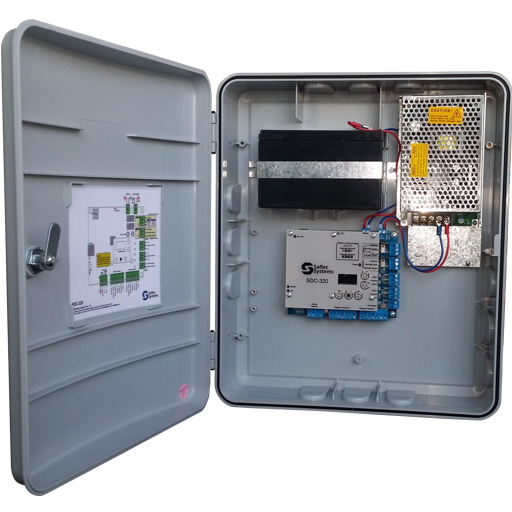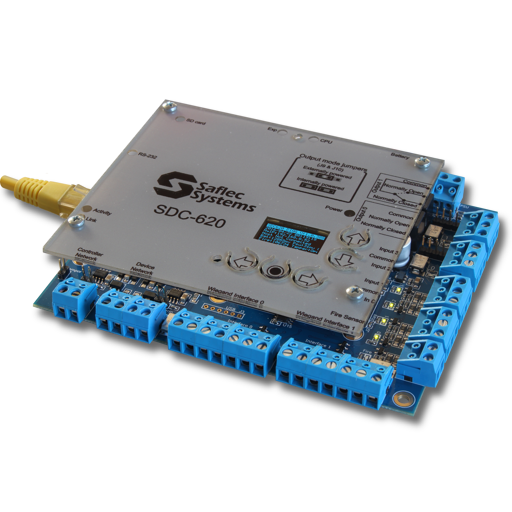Remote I/O RF Door Expansion Board
Product Code: SEB-721
This device is an RF receiver with Input and Output capabilities. Uses code-hopping 433MHz RF remotes with up to 4 buttons, and allows each button to perform a different function. It has 2 relay outputs (potential free contact/powered output) and 4 programmable digital inputs.
This unit offers the flexibility of using a remote control as opposed to a proximity card or biometric reader with the benefit of operating it from inside a vehicle. This solution is great for access points where automatic vehicle traffic barriers are used without adequate weather protection.
The remotes are allocated to the user in the same fashion as a normal RF tag or biometric template in SACS. The remotes are managed from a central point (SACS, PA or EA) making the usual access levels like scheduling, anti-passback and zone control available. All transactions are recorded unlike normal gate remotes where no transaction is logged.
Supports up to 30 000 or more remotes* (system controller dependent)
Controls up to 4 access points (1- 4 buttons & 2 additional outputs on the system controller)
*Increased capacity as per the SDC-650 system controller.
Key Features
- ROn-board RF receiver.
- RCan utilise up to 4 buttons
- RTransmitters can be uniquely linked to an individual
- R16 units can be connected per door controller
- RRobust RS-485 controller communication
- R4 Digital Inputs
- R2 Relay Outputs (Potential free/Powered output)
- RRotary coded address switch for easy addressing
NOTE: This unit cannot be fitted onto the SDC-320 Wiegand Controller!
If you have any additional questions about the operation of the SEB-710 IO Expansion Board, please don’t hesitate to contact Saflec Systems’ knowledgeable sales team for more information.
About the product
The SEB-722 Remote IO Expansion Board provides a versatile solution for expanding the input and output capabilities of your access control system. With 8 relay outputs (potential-free contacts/powered outputs) and 8 programmable digital inputs, the SEB-710 IO Expansion Board also features 8 additional connection points that can be configured as either 8 relay outputs or 8 digital inputs. This allows the board to be configured to provide either 16 outputs and 8 inputs or 8 outputs and 16 inputs.
The board is designed for optimal performance and a hassle-free installation process. It features a separate 12Vdc power input connector for connecting an external power supply, ensuring sufficient power is provided to all the output devices when required. Additionally, our device includes diagnostic LEDs mounted close to their relevant terminals, providing additional support and guidance during installation.
If you’re looking to expand the capabilities of your access control system, the SEB-710 IO Expansion Board is an ideal solution.
Installation
The SEB-710 IO Expansion Board offers a seamless integration with both the SDC-650 and SDC-620 Multiple Door Controllers, providing an expanded and flexible access control solution that can be tailored to meet the unique needs of your organization.
The board is easily mounted inside the enclosure of the SDC-650 or SDC-620 controller, fitting seamlessly below the main controller board. With the included stand-offs and nuts, installation is a breeze. The board connects to the controller through an expansion cable that is attached to the expansion headers on both boards.
Once connected, the main controller will detect the device and indicate this on its LCD display in the configuration section, ensuring a hassle-free setup process.
Operation
The SEB-710 IO Expansion Board operates by connecting to the expansion ports on the SDC-650 Multiple Door Controller or SDC-620 Ethernet Controller and expanding the input and output capabilities of the controller. Once connected and configured, the SEB-710 IO Expansion Board can receive inputs from external devices, such as doorc ontacts or motion sensors, and send outputs to devices such as locks or buzzers.


